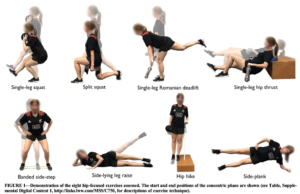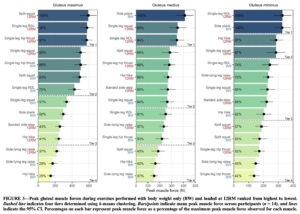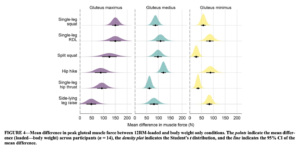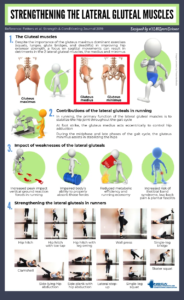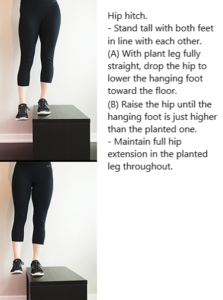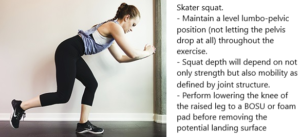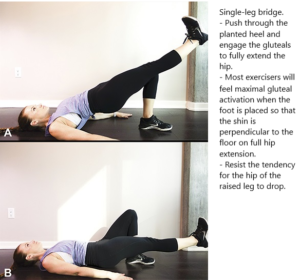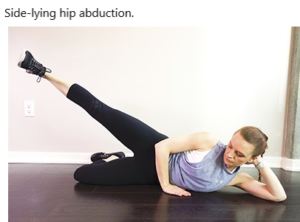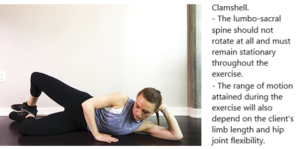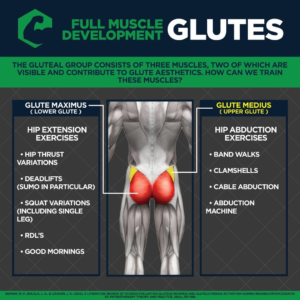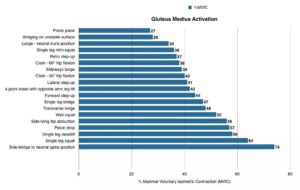GLUTE MEDIUS/MINIMUS – RESEARCH
Click on Image to Enlarge
Weak Glute Medius-Minimus causes Hip Drop and Hip Internal Rotation stressing the Hip Joint, the Lateral Hip & the Knee
TRAINING
GLUTEUS MEDIUS
– Aging
Age-related muscle atrophy in the lower extremities and daily physical activity in elderly women – 2011 – Ikezoe
Procedure
– relationship between age-related declines in muscle thickness of lower extremities daily physical activity in elderly women
– 20 young women and 17 elderly women residing in a nursing home
– Daily physical activity was evaluated using life-space assessment (LSA) which assessed degree of independence
Results
– Only the Gluteus Medius was significantly associated with the LSA score
EMG STUDIES
GLUTEUS MAXIMUS-MEDIUS-MINIMUS
– Multiple Exercises
Gluteal Muscle Forces during Hip-Focused Injury Prevention and Rehabilitation Exercises – Collings 2023
Procedure:
– 14 female footballers (18-32 yr old) with at least 3 months of lower limb strength training experience.
Review:
– PhysioTutors.com
– Hip extension–dominant movements (split squat, single-leg squat, RDL, and hip thrust) created similar muscle forces in the gluteus medius and minimus compared to hip abduction movements (hip hike, banded side step, side-lying leg raise). Thus when you want to target the lateral stabilizers of the hip, you can use more functional hip-extension dominant exercises
– The results indicate that for many exercises, the gluteus minimus produced more force compared to the gluteus medius, when the force production was normalized to the muscle size, particularly for hip hikes, side-lying leg raises, and side planks. As the gluteus minimus is more of a hip stabilizer by helping the capsule hold the femoral head in the acetabulum, you can use these exercises to increase local hip stabilization.
– Subjects with gym experience and playing rugby were included and this may not be generalizable to people suffering from hip pathology or injury. The same is true for sex as all players in this study were female.
GLUTEUS MEDIUS
– Multiple Exercises
Exploring the Role of the Lateral Gluteal Muscles in Running: Implications for Training – Fetters – 2020
Exercises
– The hip hitch produces high levels of muscle activity in all sections of the gluteus medius and minimus
– The single-leg bridge, clamshell and side-lying hip abduction produce high levels of the gluteus medius
– The side-lying hip abduction also elicits high levels of activation in the posterior segment of the gluteus minimus
Running and other Dynamic Activity
– Because running is a dynamic activity involving multi-joint movement, it’s important to integrate compound resistance training exercises.
– Unilateral, closed-chain, exercises, especially, can be considered sports-specific to runners.
– These exercises functionally train the lateral gluteals to stabilize the hips, just as they are required to do during the single-leg stance phase of running.
– Unilateral compound exercises like lateral step-up, single-leg squat, and skater squat produce high levels of gluteus medius activation
1
GLUTEUS MEDIUS
– Multiple Exercises
Gluteus Minimus and Medius Muscle Activity During Common Rehab Exercises in Healthy Postmenopausal Women – Ganderton – 2017
Exercises
– For single leg exercises participants placed one hand on a chair or the wall; testing non-stance leg
Hip Hitch . Toe Tap . Leg Swing . SHA – Standing Hip Ab-duction . Sit to Stand . Split Squat . Clam
Results
Gluteus Medius – Anterior: Swing 75 . Hitch 73. Toe Tap 70 . Split Squat 50 . SHA 40 . Sit to Stand 30 . Clam 5
Gluteus Medius – Middle: Swing 70 . Hitch 50. Toe Tap 40 . Split Squat 30 . SHA 30 . Sit to Stand 20 . Clam 10
Gluteus Medius – Posterior: Swing 60 . Hitch 50. Toe Tap 40 . Split Squat 35 . Sit to Stand 30 . Clam 30 . SHA 25
Gluteus Minimus – Anterior: Hitch 60 . Swing 60 . Toe Tap 50 . SHA 45 . Split Squat 25 . Sit to Stand 15 . Clam 10
Gluteus Minimus – Posterior: Swing 80 . Hitch 70. Toe Tap 70 . Split Squat 70 . SHA 40 . Sit to Stand 30 . Clam 10
GLUTEUS MEDIUS
– Multiple Exercises
Review and Analysis of Common Therapeutic Exercises that Generate Highest Muscle Activity for Glute Medius – Moore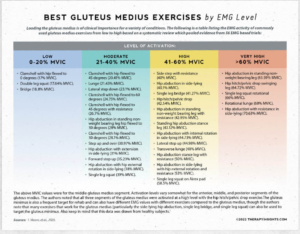
Introduction
– Evaluate high >40% MVIC EMG activity in the GMed (anterior, middle and posterior)
Results for Stabilization Exercises
Hip Hitch and Pelvic Drop 46,52,55,63,67,68,70,72,78,89,96
– 8 Studies: Anterior 41%, Middle 43%, Posterior 43%
– 1 study46 with 3 different variations of the hip hitch/pelvic drop: Anterior 68-74%; Middle 41-65%; Posterior 45-60%
Step-ups Forward & Lateral – Middle Gluteus Medius: 21 studies5,48,49,51–53,57,64,65,68,71,77,78,83–85,88,91–94
– 21 Studies: Forward Step-up = Middle 35%; Lateral step-up = Middle 45%
– Adding resistance to a Lateral Step-up = Middle 40%
– Wide Variations: technique; step height; step distance; concentric and eccentric phase; stepping or supporting leg measures; and addition of external resistance
– 1 study 52 Anterior 88%, Middle 85%, Posterior 81% for the forward step up and over exercise
Lunge and Split Squat: 10 studies46,50,64,65,70,71,78,81,92,95
– 10 Studies: Forward Lunge Middle 21% and Side lunge Middle 22%
– 1 study 46 measured rear-foot elevated lunge Bulgarians (dip test): Anterior 45%, Middle 71%, Posterior 28%
– There was some variation between the studies on lunge technique, active range of movement and movement plane.
Single-Leg Squats: 15 Studies 48,52,57,64,65,67,68,70,81,83–88
– 13 Studies: Middle 39%
– Large variations did however exist between the studies including squat depth, exercise technique and number of repetitions
– 1 Study 52 Anterior 90%, Middle 92%, Posterior 87%
– 1 Study 62 Single leg squat with isometric hip abduction and isometric hip adduction: middle 27-31%; posterior 22-33%; anterior 42% for isometric adduction, 19% for isometric abduction.
Single Leg Wall Squats
– 4 Studies Middle 32%.63,83,84,88
– 1 Study: 62 Single leg wall squat with isometric hip abduction or isometric hip adduction. Anterior 13-29% Posterior 28-44%
Squats with or without medial or lateral resistance, or wall support: 6 studies 54,57,61,78,89,90
– squats Middle 18%
– squats with resisted abduction Middle 35%
Bridge: 7 studies 66,68,71,78,97–99
– Single Leg Bridge: 6 studies Middle 41%
– Double Leg Bridge: 5 studies66,71,78,97,99 Middle 19%
Standing Hip Ab-duction Stance Leg: 4 studies 46,59,72,82
– 2 Studies: Middle 43%
– 1 Study 46 Anterior 56%, Middle 30%, Posterior 41%
Results for Hip Ab-duction
Standing Hip Ab-duction Swing Leg
– 2 Studies: had added external resistance Middle 43% 72,82 There was however a high degree of heterogeneity.
– 1 Study59 without added resistance recorded Middle 64%
Side-Lying Hip Ab-duction
– 8 Studies: Middle 40%; external resistance further increased activity levels to very high although there was a high degree of heterogeneity .56,58,66,68–79
– 4 Studies: Middle hip abduction with internal rotation 45%; hip abduction with external rotation 38% 66,75,76,79
Side-Lying Clams
– There were wide variations between studies for exercise technique; angle of hip and knee flexion; repetitions; and use of external loading
– 10 Studies: Middle 17-28% 46,58,66,68–70,73,78,80,81
– 1 Study: Anterior 3%; Middle 13%, Posterior 23%; Altering the angle of hip flexion or trunk position had minimal effect 46
GLUTEUS MEDIUS
– Multiple Exercises
Review of studies evaluating gluteus maximus and gluteus medius activation during rehab exercises .
Michael Reiman – 2011
Procedure
– Studies that evaluated activation of Glute Medius during rehab exercises; Note: subjects included in this review were healthy
Results for Gluteus Medius
– the following can affect EMG activity:
(1) trunk position (2) movement direction (3) base of support
– EMG ranged from 74% to 27% MVIC; strength gains are expected for activation levels = or >40% MVIC
· 74% – side bridge to neutral spine position
· 64% – 1-leg squat
· 58% to 52% – 1-leg RDL; hip hike; side-lying hip ab-duction; wall squat
· 48% to 40% – transverse lunge; 1-leg bridge; forward stepup; bird dog; lateral stepup; clam @30º hip flexion
· 39% to 34% – sideways lunge; clam @60º hip flexion; retro backward stepup; single leg 1/4 squat; lunge neutral trunk
· 28% to 27% – bridging on stable surface; prone plank
UPPER GLUTEUS MAXIMUS, GLUTEUS MEDIUS, TFL
– Multiple Exercises
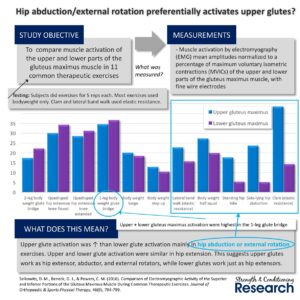 Which Exercises Target the Gluteal Muscles While Minimizing Activation of the Tensor Fascia Lata? – 2013 – Selkowitz
Which Exercises Target the Gluteal Muscles While Minimizing Activation of the Tensor Fascia Lata? – 2013 – Selkowitz
Procedure
– To compare hip abductor muscle activity
– determine which exercises are best for activating the gluteus medius and the superior portion of the gluteus maximus, while minimizing activity of the tensor fascia lata (TFL).
– 20 healthy persons participated.
– EMG obtained from the gluteus medius, superior gluteus maximus, and TFL muscles using fine-wire electrodes as subjects performed 11 different exercises
Results
| Exercise | Tensor Fascia Lata | Gluteus Medius | Superior Gluteus Maximus |
|---|---|---|---|
| Side-lying hip abduction | 32.3 ± 13.1 | 43.5 ± 14.7 (P = .012)† | 23.7 ± 15.3 (P = .033)‡ |
| Bilateral bridge | 8.2 ± 7.4 | 15.0 ± 10.5 (P = .011)† | 17.4 ± 11.9 (P = .008)† |
| Clam | 11.4 ± 11.4 | 26.7 ± 18.0 (P = .006)† | 43.6 ± 26.1 (P<.001)† |
| Hip hike | 31.4 ± 14.4 | 37.7 ± 15.1 (P = .196) | 17.7 ± 15.2 (P = .001)‡ |
| Lunge | 21.6 ± 14.5 | 19.3 ± 12.9 (P = .623) | 20.1 ± 11.1 (P = .728) |
| Quadruped hip extension, knee extending | 15.6 ± 9.3 | 27.3 ± 14.9 (P<.002)† | 28.5 ± 16.6 (P<.007)† |
| Quadruped hip extension, knee flexed | 18.7 ± 10.6 | 30.9 ± 15.2 (P = .001)† | 30.1 ± 12.5 (P = .012)† |
| Sidestep | 13.1 ± 7.1 | 30.2 ± 15.7 (P = .002)† | 27.4 ± 16.7 (P = .002)† |
| Squat | 4.6 ± 3.8 | 9.7 ± 7.3 (P = .017)† | 12.9 ± 7.9 (P<.001)† |
| Step-up | 21.4 ± 11.4 | 29.5 ± 14.9 (P = .065) | 22.8 ± 15.6 (P = .754) |
| Unilateral bridge | 18.1 ± 12.9 | 30.9 ± 20.7 (P = .007)† | 34.6 ± 16.8 (P = .001)† |

